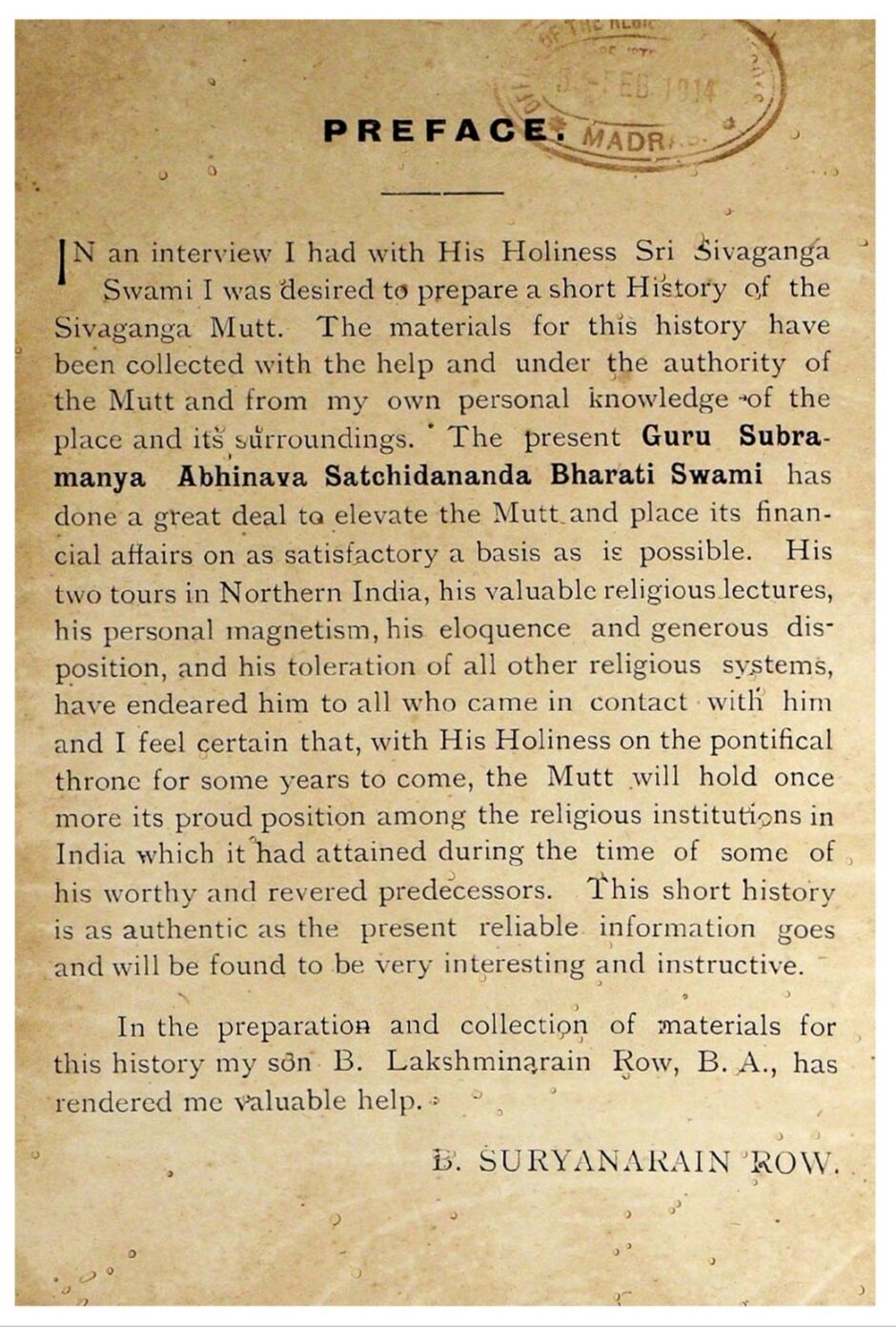Disciples beware : Help or guidance from another kindred religious institution, like giving diksha or suggesting a successor, doesn’t make your Math a shakha of someone else. It’s only an Act of Goodwill, Not Authority. Every Math is fully Independent, and any claim of control or subordination goes against Article 26 of the Indian Constitution, which protects each Math’s right to manage its own religious and internal affairs.
Category: Sivaganga
Sivaganga math Succession (1918-19)
(Contd.)
After the Sivaganga Acharya’s maha-samadhi in 1918, the Math was placed under temporary care through a committee of disciples belonging to the Math, by the Muzrai Department, until the young Acharya took charge. This record shows how the Mysore Kings respected the Sivaganga Math’s religious traditions and secular affairs, allowing its own sishyas to manage them in accordance with the customs and usages of the Math. It stands as a model for present-day State Governments on how ancient religious denominations should be protected from any kind of external interference.
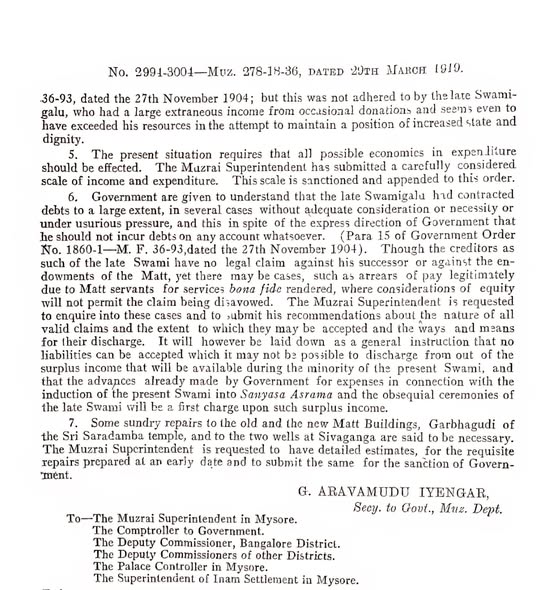
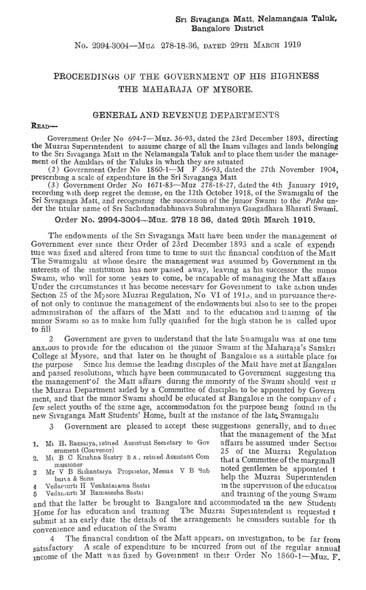
Appointment of Successor of Sivaganga Math (1918-1919)
Sri Sivaganga Math was founded in 1615 by Sri Sankara Bharati Swami at the request of the Mysore King. It has always been an independent Advaita Math, not under any other Math. This 1918 Government note records the passing of the then Swamigal of Sri Sivaganga Math at Pondicherry and the arrangements made by the Mysore Muzrai Department for the rituals in connection with his maha-samadhi and succession. The late Swamigal, with the approval of His Highness the Maharaja of Mysore, had chosen Vedamurti Rama Sesha Sastri to be initiated into Sanyasa Ashrama as his successor. After his demise, the Government also recognized the new head as Sri Sachidananda Abhinava Subrahmanya Gangadhara Bharati Swami. Earlier, in 1831, the Maharaja of Mysore had settled a dispute between the Sivaganga and Tunga Maths by declaring that the Sivaganga Math shall enjoy the same rights and privileges as Tunga Math, affirming its equal and independent standing. Further, the Government Proceedings dated 4th January 1919 issued by the General and Revenue Departments of His Highness the Maharaja of Mysore formally recognized this succession. The order records, with deep regret, the Swamigal’s passing and confirms that, in accordance with the prior approval of the Government, Vedamurti Rama Sesha Sastri was inducted into Sanyasa Ashrama and recognized as the new head under the title Sri Sachidanandabhinava Subrahmanya Gangadhara Bharati Swami. Neither the previous Swami nor the Government sought any permission or approval from any other Matha for this nomination or installation, confirming that the Sivaganga Math is a separate religious denominational institution.
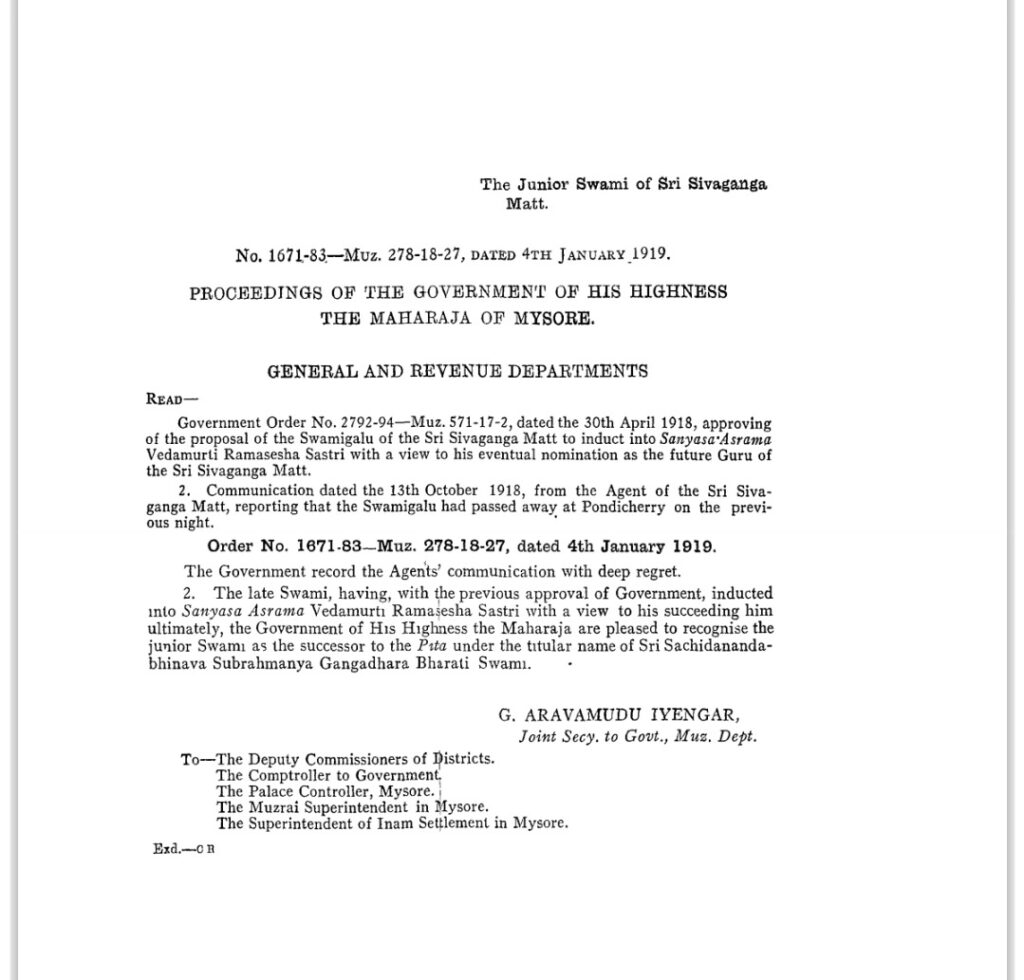
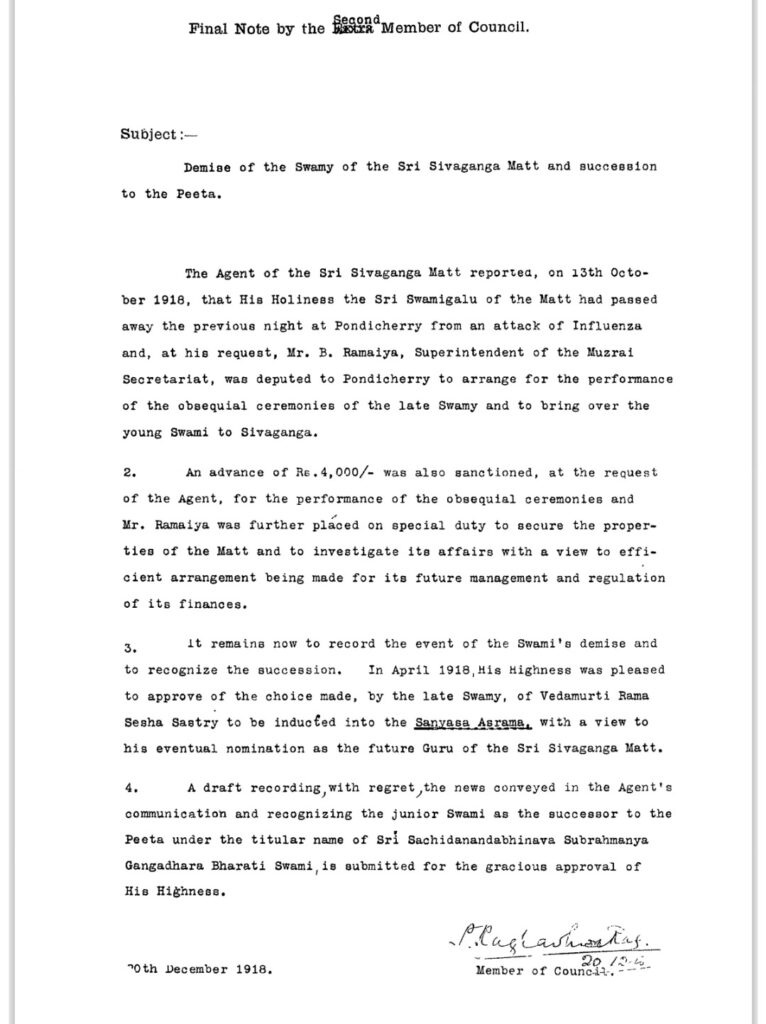
FAQs: Why Tunga matha should not claim supremacy?
Q: Why Tunga Mutt In Karnataka Should Not Claim Supremacy Over Other Shankarite Institutions?
A: There had been several historical disputes where the Tunga Math in Karnataka, a monastic institution associated with the Advaita Vedanta tradition and Shri Vidyaranya Swami, sought to assert its supremacy over Moolamnaya Kanchi Math, Dakshinamnnaya Kudali Math and other Shankarite institutions.
1. Tunga Math vs. Kudali Math: In the 19th century, Tunga Math claimed Kudali Math as its branch and sought legal restrictions on the Dakshinamnaya Kudali Math’s rights. However, courts consistently ruled Kudali Math as independent Shankarite institution, allowing it to retain its distinct honors.
2. Tunga Math vs. Kanchi Math: Tunga Math tried asserting privileges over the Kanchi Kamakoti Math, established by Shri Shankara Bhavatpada, including rights to repair the Shrichakra Tatankas in the Jambukeshwaram Temple etc. The courts repeatedly dismissed Tunga math’s claims, upholding Moolamnaya Kanchi Math’s traditional rights, independent status and supremacy over Tunga Math.
3. Tunga Math vs. Shivaganga Math: Both institutions approached the Mysore Maharaja in 1831 to resolve disputes over privileges. It was finally decided that Shivaganga Math held equal rights, effectively denying Tunga’s claim to superiority.
4. Tunga Math vs. Virupaksha Math: During the 19th centiry, the Tunga Math attempted to curb the activities of Virupakasha Math.The Nizam’s High Court dismissed Tunga Math”s claims, affirming Virupaksha Math’s traditional rights to function as independent Shankarite institution.
In all these instances, Tunga Math’s attempts to claim dominance were legally challenged and defeated by the Kanchi, Kudali and other maths whose ancient records proved their independence and distinct privileges throughout history.
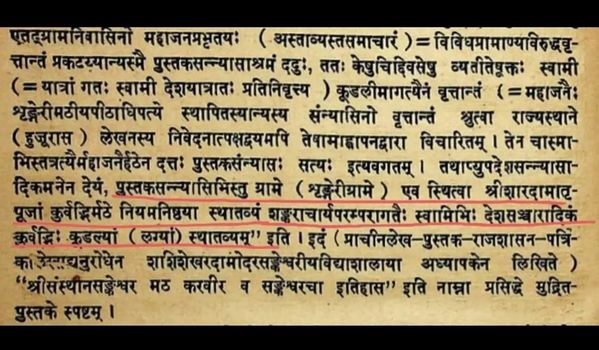
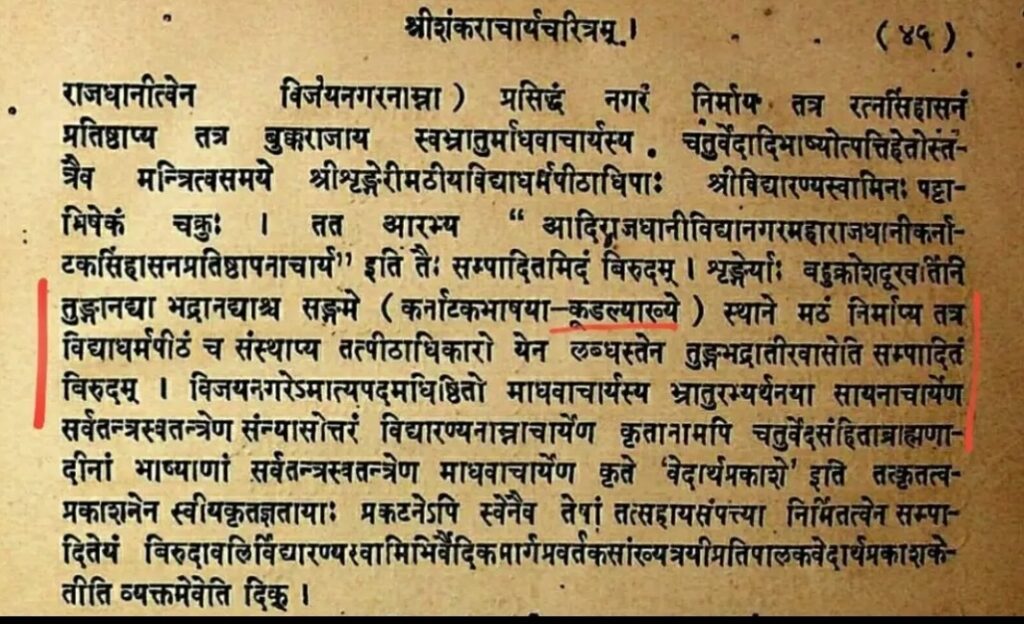
A Short History of the Shivaganga matha…1
The Shivaganga Mutt’s brief history by B. Suryanarain Row is a rich compilation of the ancient history of Shivaganga kshrtra, Shri Adishankaracharya, the matha’s foundation & the lineage of Jagadguru Acharyas and traditional honours shown to this Sankarite institution by the Mysore Principality.
This 1914 publication not only explores the historical facets but also highlights the various privileges and special status enjoyed by the Shivaganga matha over the ages akin to the Sringeri matha founded by Sri Adishankara Bhagavatpada on the bank of Tungabhadra. The Mysore Government’s recognition, backed by precise legal and historical evidence, is meticulously examined by the author. This unique work dispels the misconception of considering the Shivaganga matha as a mere branch or shakha of the Tunga matha, providing clarity on its distinct identity and significance.
ORIGIN OF THE SIVAGANGA MUTT
” After Sri Sankaracharya’s intellectual success over Mandana Misra and his incarnate spouse Saraswathi, it has been shown how the latter was about to go away to Brahma Loka in her divine form, when Sankara bound her by Vana Durga Mantra, and beseeched her to go with him… She agreed to send her grace with him on some condition and Sankara proceeded to the South.
When he came to Kudali (Kannada to join) about 9 miles from Shimoga, where the confluence of the Thunga and the Bhadra takes place, he seems to have forgotten to comply with the terms on the strict observance of which Goddess Sarada promised to bestow her grace…
On contemplation Sankara saw that the Goddess was inclined to stop at this holy junction of the two grace on Thunga and Bhadra rivers (Kudali kshetra).
Sankara repeated his prayers Sarada observed that during the ten days of the Navaratri, she would grace Sringeri (near Tunga), with her complete glory and during the rest of the year a portion of it will be with her statue there (Tunga Bhadra Sringeri-Kudali)…A Mutt was established at Kudali with a Swamy who has spiritual jurisdiction over portions of Mysore and Maharatta countries.
From the tables appended, it will be seen that Abhinava Nrisimha Bharati was the 25th from Adi Sankaracharya and succession of the Gurus on the pontifical throne of Sringeri. He sat on it from 1599 to 1622 A.D. the 14th from Sri Vidyaranya in the direct line of succession….
The Kings of Keladi rose to great importance and power at about this period and Sringeri was in their political jurisdiction. Nrisimha Bharati I. ordained Sankara Bharati in 1615 A.D. and the latter received an excellent training and made several successful tours in N. and S. India. He settled many religious disputes and attended to the spiritual wants of his disciples.
Venkatappa Naika who ruled successfully at Keladi from 1582 to 1629 A.D. asserted his independence after the fall of the Vijayanagar power. He was a powerful ruler and drove back the invasion of the Bijapur forces under the famous Mohomedan General Ranadulla Khan. He extended his territories on the North and the East to Masur, Shimoga, Kadur and Bhuvanagiri or Kavala durga.
The absence of Sankara Bharati, and a properly constituted Guru threw the affairs of the Sringeri Mutt into great confusions and Venkatappa Naika through his royal power and influence had to re-establish the Matha in Sringeri in 1621 A.D.
(See P. 158 Mysore and Coorg from Ins. Rice.)
While travelling in the Mysore country, Raja Wodeyar requested Sankara Bharati to consecrate a Mutt at Sivaganga as it was a very holy place, so that the Karnatic country under his political supremacy may have a Guru to administer to the spiritual wants of his subjects. Being highly pleased with the Raja’s request and his sincere solicitude for that spiritual welfare of his people. Sankara Bharati swamy founded a Mutt in Sivaganga. “
– A Short History of Sivaganga Mutt By B.Suryanarain Raw, Bangalore (1914)


